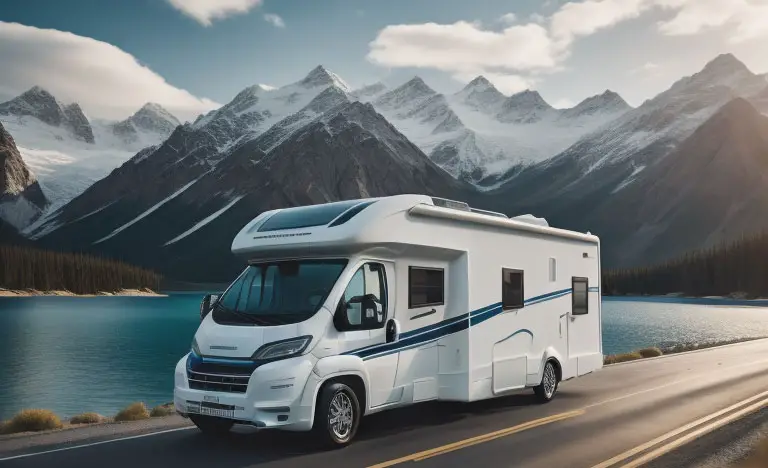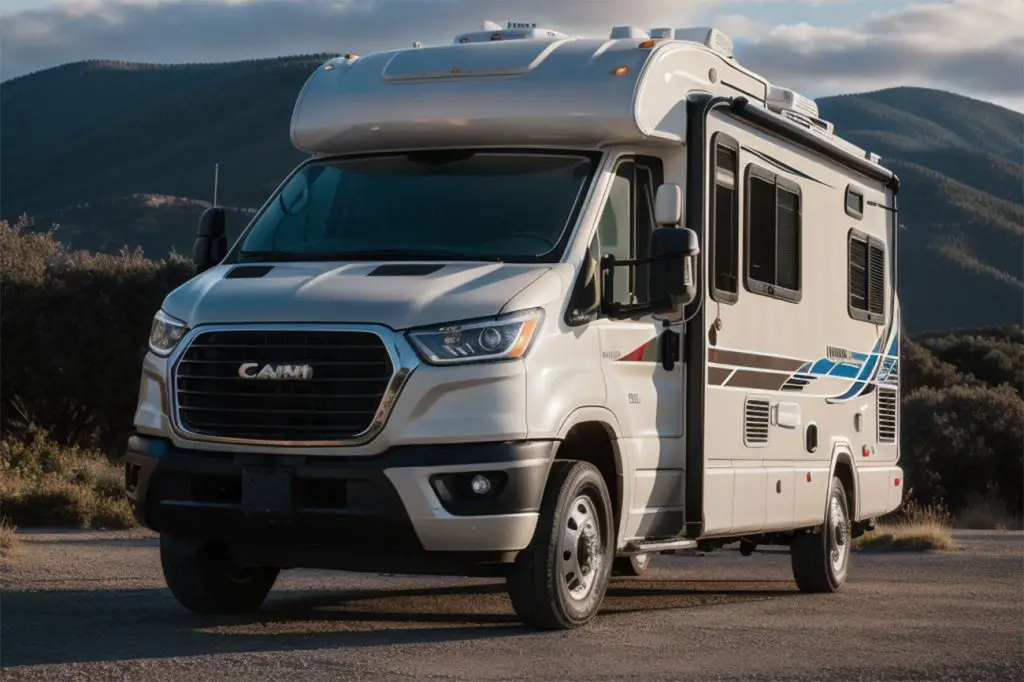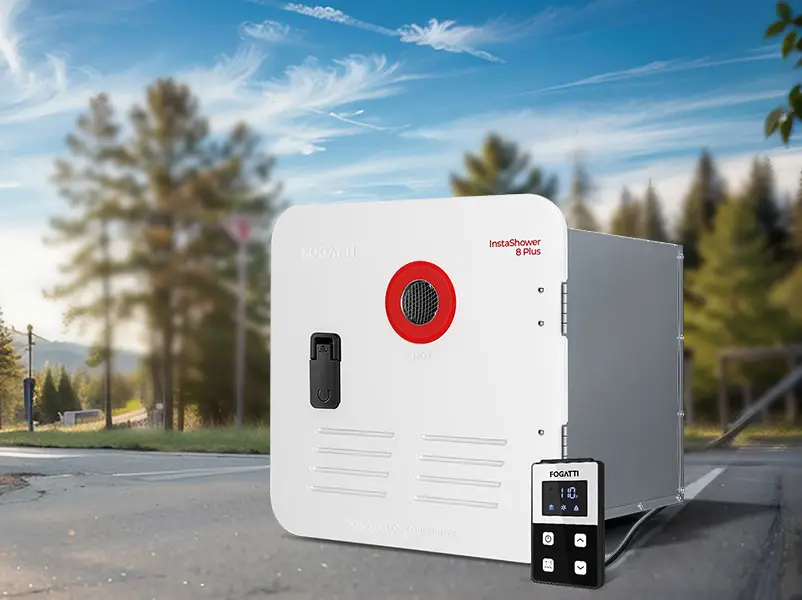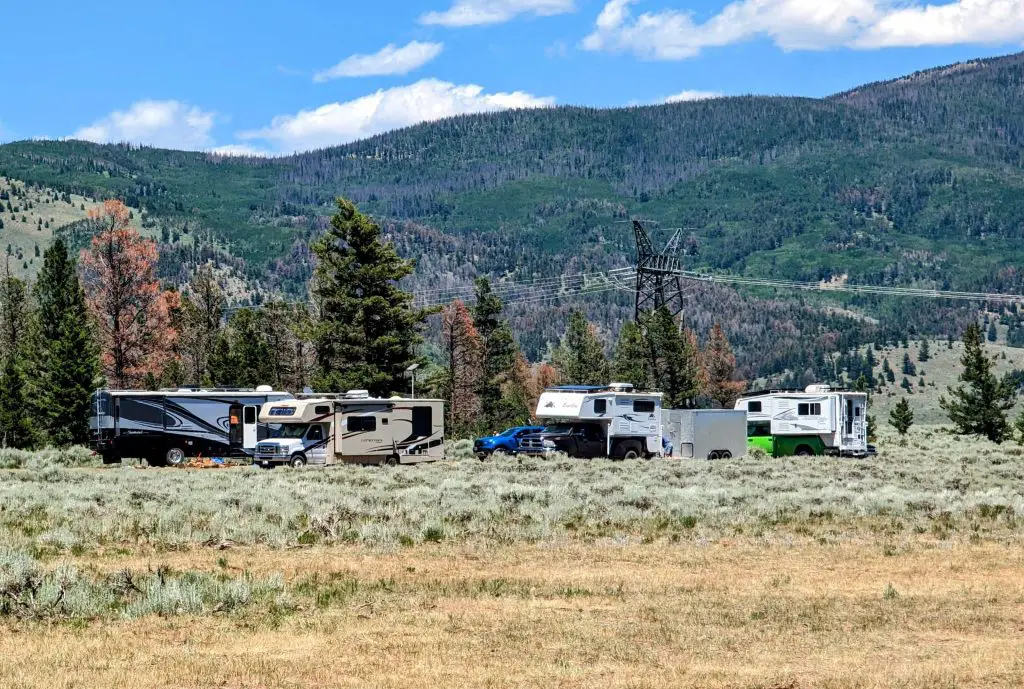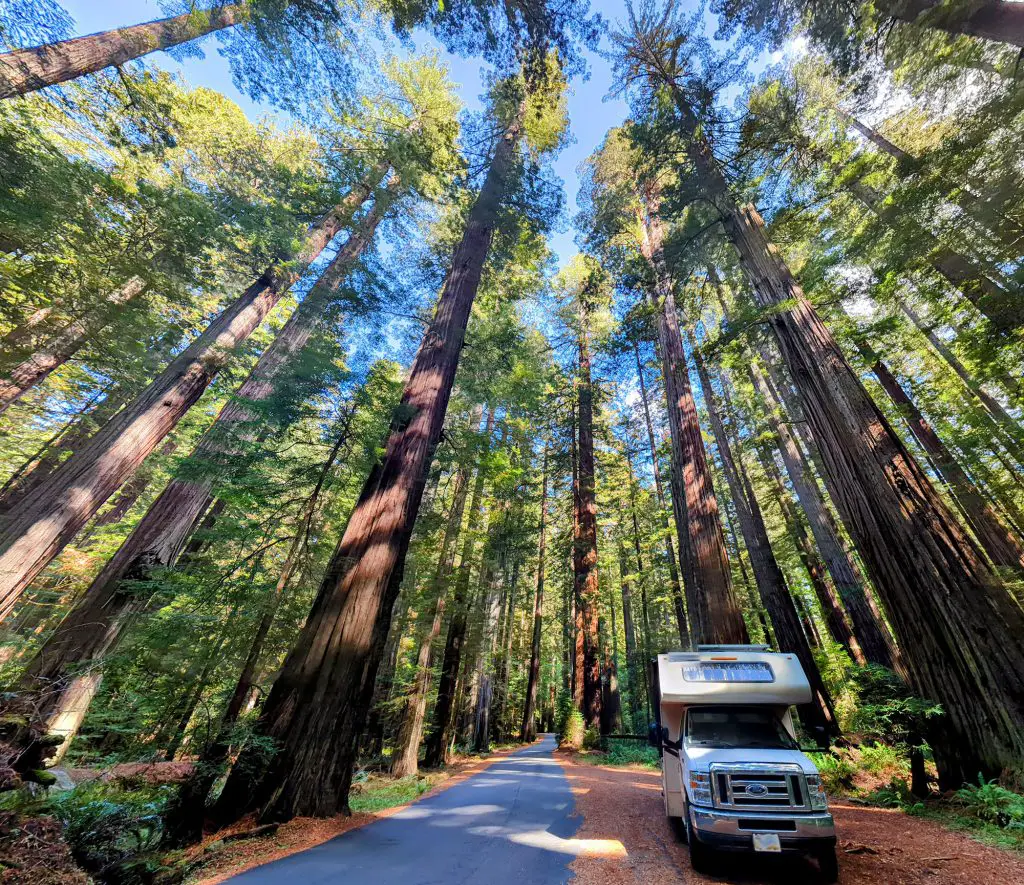Key Takeaways:
- Transporting The RV: Transporting an RV from the US to Europe involves complexities and expenses, including shipping methods, costs, and regulations. We discuss it in this post.
- RV Types and Sizes: European RVs are smaller and more compact, emphasizing maneuverability. US RVs are spacious and tailored for extended living, offering amenities for comfort.
- Road Infrastructure: European roads can be narrow and winding, challenging for larger RVs. US roads are spacious and user-friendly, suitable for various vehicle sizes.
- Campgrounds: European campgrounds offer basic facilities, while US campgrounds provide diverse amenities.
- Cultural and Scenic Diversity: Europe offers a rich tapestry of cultures and historical treasures within short distances. The US boasts diverse landscapes, catering to different outdoor enthusiasts.
- Regulations and Driving: European countries have varying driving regulations and road signs, requiring travelers to stay informed. The US has consistent traffic rules but may have different speed limits and parking restrictions.
- Travel Costs: Europe may have higher travel costs, including toll roads and fuel, but offers cost savings due to shorter distances. The US provides budget-friendly options for RV travel, with lower expenses for fuel and camping facilities.
- Language Barrier: English is common throughout the US, while travelers in Europe may encounter language changes, necessitating learning local phrases.
- Hookups: Differences exist in electrical systems and plug standards between the US and Europe, requiring adapters and converters.
- Best Time To RV in Europe: Summer is peak season, but shoulder seasons offer fewer crowds and milder temperatures. Winter RVing can be enjoyable in southern Europe, with reasonable rental prices and delightful weather.
As a seasoned traveler who has explored the open roads both in the USA and across Europe, I often come across a question in RV-related Facebook groups, whether it’s worth taking your RV from the United States to Europe or if it’s more practical to rent one once you arrive. With extensive experience driving through Europe with a car and living the RV lifestyle in the USA, I’ve gathered valuable insights and real-world perspectives that shed light on this topic. In this blog post, I’ll offer a comprehensive comparison, presenting the facts and considerations to help you make the right choice for your next adventure. Whether you’re a fellow traveler or someone considering their first European journey, this guide is tailored to equip you with the information you need to decide between the RV you know and love or a new European companion.
RV Types and Sizes:
Europe
In Europe, RVs often come in smaller and more compact sizes compared to their American counterparts. European RVs usually don’t have slides and are under 26 feet (8 meters). While spaciousness may be sacrificed, these European RVs are designed with maneuverability and versatility in mind. They are typically not intended for full-time living but excel in providing an efficient and comfortable travel experience.
U.S.
In contrast, RVs in the USA are renowned for their spaciousness and are frequently tailored for extended or full-time living on the road. RVs in the US are available in a wide range of sizes, spanning from compact vans to impressive 40-foot models equipped with multiple slide-outs. These ‘home away from home’ vehicles come equipped with generous amenities and comforts that cater to long-term travelers. In the U.S., it’s more common to find conventional flush toilets in RVs, resembling residential bathroom facilities. The electrical systems typically operate on the American standard, 30 and 50 AMP ensuring that RV owners can easily access power hookups and maintain their onboard systems throughout their journey. This emphasis on comfort and convenience aligns with the American RV culture, where roadtrippers often embrace a sense of home wherever they go.
Road Infrastructure
Europe
European roads can indeed present a unique set of challenges, as they often wind through picturesque but narrow paths. For RV travelers, particularly those with larger rigs, navigating these roads can be a bit more demanding in certain areas. Despite these road constraints, Europe offers a silver lining with its extensive network of well-established campsites and RV-friendly areas.
While a van may be more manageable, it’s important to note that even a Class B+ RV can pose challenges on some European roads. European road infrastructure can be narrow and winding, which may require extra caution and planning when traveling with larger vehicles. To navigate more effectively, it’s a good idea to invest in a quality GPS designed for European travel. These devices typically allow you to input your vehicle’s dimensions, helping you avoid potential trouble due to size restrictions on European roads.
U.S.
Traveling along the vast network of roads in the United States offers a significantly different experience for RV enthusiasts. American roads are known for their spaciousness and user-friendliness, catering to a wide range of vehicles, including larger RVs. With broad highways and well-maintained roads, RVers in the U.S. enjoy a relatively smooth and convenient journey, making it easier to cover long distances. The abundance of RV parks, campgrounds, and rest areas along the way ensures that you’re never too far from a comfortable place to park for the night. This RV-friendly infrastructure, combined with the sprawling landscapes, empowers travelers to explore the diverse beauty of the United States with ease and comfort.
Campgrounds
Europe
European campgrounds frequently stand in contrast to their American counterparts, offering a more compact and rustic camping experience. These sites often feature basic facilities, which may include essential amenities like water and electricity hookups but not the extravagant comforts found in larger RV parks in the U.S. One noteworthy aspect of European camping culture is the popularity of ‘wild camping’ in certain countries. This practice permits campers to venture into more remote and scenic locations, embracing the unspoiled natural beauty of Europe. It’s a choice that appeals to adventurers seeking a genuine connection with the great outdoors and a taste of the region’s untamed landscapes.
U.S.
Campgrounds in the United States embody the concept of variety and abundance. From vast, well-appointed RV parks to primitive and secluded sites, there’s a campground to suit every camper’s preference. American campgrounds often offer a wide array of amenities, including full hookups, showers, laundry facilities, recreational areas, and camp stores. These campgrounds are designed to provide travelers with a comfortable and convenient experience, making it easy to access the essentials while enjoying the great outdoors. Some campgrounds in the U.S. are nestled within national parks and forests, allowing visitors to immerse themselves in the stunning landscapes and pristine wilderness that America has to offer. Whether you seek a luxurious RV resort or a rustic campsite by a mountain stream, the diversity of American campgrounds ensures that there’s a perfect spot for everyone’s outdoor adventure.
Cultural and Scenic Diversity:
Europe
RVing in Europe opens the door to a fascinating tapestry of cultures, languages, and historical treasures, all conveniently nestled within short distances from one another. One of the most remarkable aspects of European travel is the ability to traverse various countries, each with its own unique charm and character, without spending endless hours on the road. This geographical proximity allows travelers to effortlessly transition from the romantic streets of Paris to the picturesque landscapes of Tuscany or the stunning fjords of Norway. Along the way, you’ll encounter an enticing array of cuisines, each a culinary masterpiece in its own right, offering a delightful exploration of flavors. Whether you’re drawn to the ancient wonders of Greece or the medieval allure of Prague, the rich cultural diversity of Europe ensures that your RV adventure is a captivating journey through history, art, and gastronomy.
U.S.
The United States unfolds a staggering expanse of diverse landscapes, spanning from the eastern and western coasts to the heartland. RVers in the U.S. have the privilege of embarking on an adventure that encompasses it all, from the rugged beauty of national parks like Yellowstone and the Grand Canyon to the serene woodlands of the Smoky Mountains, the majestic peaks of the Rockies, and the sun-soaked deserts of the Southwest. Coastal roads invite travelers to explore the stunning shores of the Pacific, the rocky cliffs of New England, and the sun-drenched beaches of Florida. Each region offers a distinct experience, and with an RV, you can witness the kaleidoscope of nature’s wonders while enjoying the comforts of your home on wheels. Whether you’re a nature enthusiast, an adventurer, or a beachcomber, the diverse landscapes of the United States are a playground for every kind of RVer.
Regulations and Driving
Europe
In Europe, it’s crucial for RVers to be mindful of the fact that driving regulations and road signs can exhibit variations from one European country to another. Each nation may have its own set of rules and traffic regulations, making it essential to stay informed about the specific requirements and guidelines in each location you visit. Furthermore, certain cities within these countries might impose restrictions on larger vehicles, including RVs. These limitations could pertain to factors like vehicle dimensions, weight, or even the hours when RVs are permitted to access certain areas. Staying well-informed about these rules ensures a smooth and hassle-free journey as you navigate the charming roads and cities of Europe.
It’s crucial to be aware of the changing toll systems and surveillance methods in European countries. Video tolls are common, and speed cameras are widespread. Some cities have green zones that necessitate special permits, and your US license plate may not register in these areas, potentially leading to violations. To avoid these situations, plan your routes carefully and research the specific requirements and restrictions of the areas you’ll be traveling through in Europe.
U.S.
While many traffic rules in the USA are consistent, it’s important to remember that speed limits can vary from one road or highway to another. Additionally, different cities and towns may have their own unique parking restrictions and local city codes to be aware of. It’s worth noting that certain areas may have restrictions on larger vehicles, such as RVs, so it’s always a good idea to stay informed and be prepared for such variations in regulations. Staying well-informed about the specific regulations in each state and locality you visit ensures a seamless and enjoyable journey while navigating the diverse landscapes and urban areas of the United States.
Travel Costs
Europe
When traveling in Europe, it’s essential to be prepared for potentially higher travel costs compared to the United States. Expenses in Europe, such as toll roads and fuel, tend to be more costly than what you might encounter in the U.S. However, the compact size of the European continent can offer a unique advantage, as it often leads to significant cost savings when covering shorter travel distances. While certain expenses might be higher, the reduced distance between cities and attractions can help offset these costs. So, while your budget may experience some variances, the richness of European culture, history, and landscapes make it a worthwhile and enriching experience for any RVer.
U.S.
In the United States, travel costs for RVers can be more budget-friendly compared to Europe. The U.S. offers relatively lower expenses for factors like fuel and fewer toll roads, making it a cost-effective destination for RV travel. The vast size of the country provides travelers with a wide range of options, from free or low-cost camping sites to reasonably priced amenities. While longer travel distances may increase fuel consumption, the abundance of RV-friendly routes, affordable camping facilities, and extensive national park systems make RVing in the U.S. an economically attractive option for those seeking to explore diverse landscapes, natural wonders, and cultural experiences across the country.
Language Barrier
Europe
While traveling through different European countries, you may encounter language changes and barriers. Although English is commonly spoken, especially in tourist areas, it can be beneficial to learn a few essential phrases in the local language of each country you visit. This effort not only showcases respect for the local culture but also proves incredibly helpful in various situations, such as ordering food, seeking directions, or engaging in basic conversations with the locals. Learning a few phrases can enhance your travel experience, foster meaningful connections, and ensure smoother communication while exploring the diverse cultures of Europe.
U.S.
English is the primary language spoken throughout the U.S., making communication easier for English-speaking travelers.
Hookups
The distinctions in RV hookups between the USA and Europe primarily revolve around differences in electrical systems, plug standards, and voltage/frequency levels. These disparities can pose challenges for RVers traveling between these two regions.
Another noticeable distinction is the prevalence of cassette toilets, a space-saving and eco-friendly alternative, which may differ from the conventional RV toilets more common in the United States. In Europe, RVs typically use a toilet cassette for black water waste and a separate release point for grey water. While traditional stink slinkies might work for each of these waste types, it can be a bit awkward to manage both systems due to their separate disposal requirements.
Propane
When it comes to propane systems, it’s essential to note that fittings and adapters vary between European countries. Expect to purchase new hoses to fit your manifold, and use country-specific adapters for exchangeable propane tanks. Keep in mind that what works in one country, such as France, may not be compatible in another, like Spain. It’s advisable to familiarize yourself with the propane standards and regulations of the specific regions you’ll be traveling to in Europe and ensure you have the appropriate fittings and adapters to safely operate your propane system.
Electrical Systems
In Europe, shoreline charging typically provides 6 amps at 230 volts with different plug head configurations. It’s essentially a trickle charge for your house batteries.
 The RV plugs in Europe are often referred to as “blue plugs” due to their blue color. It’s important to note that you can’t simply plug a regular European two-pin plug into the campground electricity when it comes to RVs. Specialized connectors and adapters are necessary to ensure proper electrical compatibility between the campground power source and your RV. This distinction is crucial to prevent any electrical issues and ensure a safe and reliable power supply for your RV. You probably have to bring some US-EU plugs with you just in case.
The RV plugs in Europe are often referred to as “blue plugs” due to their blue color. It’s important to note that you can’t simply plug a regular European two-pin plug into the campground electricity when it comes to RVs. Specialized connectors and adapters are necessary to ensure proper electrical compatibility between the campground power source and your RV. This distinction is crucial to prevent any electrical issues and ensure a safe and reliable power supply for your RV. You probably have to bring some US-EU plugs with you just in case.
[amazon box =”B08QYNSWMR”]
You will need a converter or alternatively, you can use solar panels and driving to recharge your house batteries. Using a generator is an option, but it might not make you very popular with your neighbors due to the noise. Additionally, keep in mind that your air conditioning and microwave won’t work on a shoreline connection. If you insist on using these appliances, the generator becomes your only option. It’s worth noting that European RVs typically don’t come equipped with these power-hungry amenities.
Europe: European RVs are equipped with a standard hookup called the “CEEform” or “CEE” plug. These plugs come in various amperages, such as CEE 16A or CEE 32A.
USA: The USA primarily uses a split-phase electrical system, with 120V/240V AC at a frequency of 60 Hz. Residential electrical outlets provide 120V, while some RV parks offer 240V service for larger RVs. The standard RV hookup in the USA includes a 30-amp or 50-amp service, with specific plug types (NEMA TT-30 or NEMA 14-50) to match.
Voltage and Frequency
Europe: European countries use 230V AC at a frequency of 50 Hz. European RVs are equipped to handle 230V power.
USA: The USA operates on 120V/240V AC at a frequency of 60 Hz. RV appliances and systems in the USA are designed to work with this voltage and frequency.
Adapters and Converters
Adapters serve as invaluable tools, allowing you to connect your RV to foreign electrical outlets and ensuring compatibility despite varying plug configurations. In addition to adapters, converters, also known as transformers, play a crucial role. They help adjust the voltage and frequency of the electrical supply to match the specific requirements of your RV, preventing electrical mishaps and safeguarding your onboard appliances and equipment. These essential devices enable a seamless transition between the electrical systems of the USA and Europe.
Transporting The RV
Transporting an RV from the USA to Europe and back can be a complex and expensive endeavor. The cost, duration, and process will vary depending on several factors, including the size of your RV, shipping method, departure and destination points, and any additional services or requirements. Here’s an overview of what to consider:
Shipping Methods
You can choose between different shipping methods, including roll-on/roll-off (RoRo), container shipping, or flat-rack shipping. The method you choose will affect both cost and duration. Container shipping is more secure but can be more expensive.
Cost And Duration
The cost of transporting your RV to Europe and back can vary significantly. It may include expenses such as shipping fees, customs duties, taxes, insurance, storage, and any modifications or adaptations needed to comply with European regulations. As a rough estimate, it could range from $5,000 to $10,000 or more each way, depending on the factors mentioned.
A real-life experience when shipping a Rialta (which is a Class B+ RV) from Georgia to Belgium amounted to $6,500 in the outbound journey and $5,000 to back.
To facilitate the logistics you can use a shipping expediter. Handling the intricate paperwork independently is not advisable due to its complexity. The expediter’s service came with a 15% fee, justifiably given the intricate nature of the process. It takes at least 2-3 weeks for each leg of the journey, factoring in shipping times in both directions. To keep costs down, you can choose the roll-on/roll-off shipping method, which proved to be the more budget-friendly option. If you need domestic transport, you’ll need to arrange and cover the additional expenses involved. You may be able to personally drive your rig to the port. Before shipping, remember to remove your US state plate(s) from your vehicle. Upon arrival at the destination, you can then reinstall them accordingly. It’s worth noting that theft during transit is a significant concern that necessitates careful precautions.
Choose a reputable international shipping company with experience in transporting RVs. They can guide you through the process and provide cost estimates.
Bonds
Certain ports, such as Belgium as a point of entry don’t require the posting of a bond. In contrast, countries like Germany may require a bond with a value of $10,000 or more. This bond is typically refundable when you depart and return to the US, designed to prevent the sale of your vehicle within Germany.
Licensing and Insurance
Ensure your RV is properly licensed and insured for international transport and use in Europe. Your regular US auto insurance is not applicable in Europe. Securing standard comprehensive insurance in Europe can be relatively costly, typically ranging around $1,500 per month. The exact price can vary based on the value of your RV and the extent of coverage you select. This comprehensive insurance is comprehensive in name and nature, often covering theft of items inside your RV. It’s worth considering as RV break-ins are relatively common in Europe.
To safeguard your rig during transit, acquiring marine insurance is strongly recommended. Fortunately, this insurance is relatively cost-effective and offers peace of mind throughout the shipping process.
Best Time To RV in Europe
Summer (June to August) marks the peak season for RVing in Europe but it is the time when school children are on vacation, the roads and campgrounds tend to be quite crowded, and prices for campsites soar. Planning ahead becomes a necessity, particularly in sought-after locations. The only exception is summer RVing is Scandinavia, where the crowds remain sparse, and the weather is close to perfect. It truly offers a unique and delightful experience.
The shoulder seasons (April to May and September to October) are the top recommended times for exploring the United Kingdom and Continental Europe. During these periods, the crowds have dissipated, temperatures are pleasantly mild, and rental and campground prices take a welcome dip. While some sites might close towards the end of September, overall, it’s close to perfection, and we genuinely cherish these months.
Winter RVing (November to March) can be an extraordinary experience in southern Europe, particularly in countries like Spain and Portugal. Many retirees flock south during the winter months, ensuring a decent number of campgrounds remain open year-round. Rental prices remain reasonable, the weather is delightful, and travel becomes wonderfully hassle-free.

